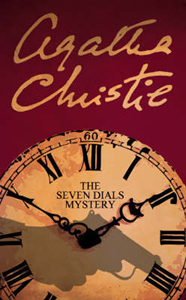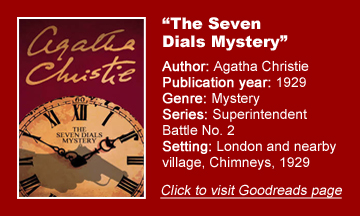I enjoyed “The Secret of Chimneys” (1925) as a classic country manor-based novel of murder detection, and was pleasantly surprised to find out that not only does the quietly thoughtful Superintendent Battle return in “The Seven Dials Mystery” (1929), but so do Bundle and other young people in her sphere.
Actually named Eileen Brent, Bundle stood out for me in part because of her name – which I find delightful, although one of my Agatha Christie-reading friends calls it “the dumbest nickname.”
‘Nancy Drew’ for adults
Bundle really comes into her own in “Seven Dials” as the leader of a group of amateur upper-class sleuths who remind me slightly of “Nancy Drew” and “The Hardy Boys.” Not in quality – obviously, Christie’s writing is vastly better than those ghostwritten YA books – but in the spirit of a group of friends solving a case.
The percentage of light fun in “Seven Dials” is higher than the life-or-death moments – although when those moments come, they are legitimate. The banter between Bundle – now a 20-something living on her own in a nearby village – and her father back at Chimneys is delightful.
Lord Caterham puts more effort into avoiding work than most people put into their actual work. Christie also has fun with absurd young people such as Socks, who describes everything as “subtle.”
Teaming up with Bundle is Bill, who – continuing from “Chimneys” – loves Bundle but assumes she’d laugh if he confessed his feelings. A cute love story eventually emerges. There’s also Jimmy, who has seen two of his friends killed – likely by the mysterious Seven Dials secret society – and Loraine, the step-sister of one of the deceased.
Each member of the quartet is vibrantly written, although Christie purposely holds back details for the sake of mystery. At one point, Bundle says she has mentally cleared only one person of the murders: Superintendent Battle.
Read today, when we know Battle is the main detective in a couple novels after this, Bundle is stating the obvious. But in 1929, it would’ve kept readers off-balance. Similar to how Colonel Race is a suspect in “The Man in the Brown Suit,” we wonder “Could Battle actually be a suspect?”
International intrigue
Also in line with “Brown Suit,” “The Secret Adversary” and “The Big Four,” “Seven Dials” is a story of international intrigue.
But here, Christie blends that broad scope – the notion that the Seven Dials society plans and executes global espionage, theft and murder – with locally based detection in the village near Chimneys, along with our heroes’ jaunts to the Seven Dials Club in London, a 40-minute drive away.
Although “The Secret Adversary” likewise mixes local and international perspectives, that one is always vast in the mystery’s scope; it’s just that Tommy and Tuppence are small-time, locally grounded sleuths.
And “The Secret of Chimneys” has a touch of the international, but it’s merely a spice to the house-based murder mystery. In “Seven Dials,” I like how the novel kicks off with a bedroom-based murder at Chimneys, then gradually gets bigger.

Ultimately, the two genres blend together beautifully, especially because of …
The final act (Spoilers)
(SPOILERS FOLLOW.)
… a trick Christie pulls that recasts the entire narrative, and arguably the theme of the novel as well.
After the surprising revelation that Battle is the head of Seven Dials, we’re quickly hit with another surprise: The Dials members are not the bad guys, but rather the good guys – an early, amateur secret service overseen by Battle. So, generally speaking, the good and bad sides are reversed from what we’ve been led to believe.
Suddenly, Bundle’s list of allies increases, but on the other hand, people she thought were her friends – Jimmy and Loraine – are the villainous masterminds.
To me, this is a turnabout on par with “The Murder of Roger Ackroyd.” In that famous book, I guessed the twist but didn’t hold that against Christie; rather, I felt closer to her smart narrative by guessing right. In “Seven Dials,” she outsmarts me (although I bet some readers guessed the true events), but again, it’s in a way that makes me feel a kinship with the novel rather than feeling left in the dust.
Battle gives an enjoyably thorough recap – but with an eye toward what really happened – and it ties together masterfully. What starts admirably enough as a jaunty reunion with some of the “Chimneys” gang ends up being an even more ingeniously plotted, layered novel.
“Seven Dials” has something to say about the very notion of secret societies. Through Battle, Christie – going “meta” before it was cool — notes that secret societies aren’t as prevalent in reality as they are in fiction.
Bundle and friends’ decisions are often rooted in clichés from spy thrillers (although, to their credit, they often pause to wonder if reality might be different). So by diving into this genre through book-smart rather than street-smart characters, Christie comments on common misconceptions.
Throw in humor, colorful young sleuths and romance, and “The Seven Dials Mystery” ends up as a sneaky gem to cap Christie’s first decade as a published author.
Every week, Sleuthing Sunday reviews an Agatha Christie book or adaptation. Click here to visit our Agatha Christie Zone.


